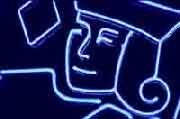Sunday, June 17, 2007
Postcard from Northumberland
Flodden Field
Of all the pitched battles fought between the English and the Scots (eg Bannockburn 1314, Wembley 1977), the largest and bloodiest skirmish took place nearly 500 years ago on Flodden Field. King James IV of Scotland thought it would be a good idea to declare war on England while King Henry VIII was away fighting in Italy. And so, on a damp September afternoon in 1513, a huge Scottish army assembled high above the Tweed Valley on the eastern edge of the Cheviot Hills. Their defensive position was strong, but a cavalier advance down from the hilltop proved a costly mistake. Within just three hours the advancing English army had slaughtered ten thousand men, and one of those was the King himself.
They grow barley in Flodden Field today, beneath a tall stone cross which commemorates the dead from both sides [photo]. Standing atop the ridge you can look out across the battlefield, now verdant farmland, towards the slopes down which so many Scottish pikemen made their final charge. A narrow boggy gully divides the enemy positions, once running with blood, where skylarks now play. Recently a mile-long walking trail has been established around the heart of the battlefield, with a series of excellent information boards relating different chapters in this sorry tale of mass inter-national carnage. A couple of miles to the north the Scottish border weaves invisibly across a silent valley. The site has an eerie silence, and an inappropriate beauty.
Also worth a visit...
Ford and Etal: A historic Borders estate, featuring a riverside narrow gauge railway which chugs aimlessly from Heatherslaw Corn Mill to Etal Castle.
...or read more in my monthly archives
Jan26
Jan25 Feb25 Mar25 Apr25 May25 Jun25 Jul25 Aug25 Sep25 Oct25 Nov25 Dec25
Jan24 Feb24 Mar24 Apr24 May24 Jun24 Jul24 Aug24 Sep24 Oct24 Nov24 Dec24
Jan23 Feb23 Mar23 Apr23 May23 Jun23 Jul23 Aug23 Sep23 Oct23 Nov23 Dec23
Jan22 Feb22 Mar22 Apr22 May22 Jun22 Jul22 Aug22 Sep22 Oct22 Nov22 Dec22
Jan21 Feb21 Mar21 Apr21 May21 Jun21 Jul21 Aug21 Sep21 Oct21 Nov21 Dec21
Jan20 Feb20 Mar20 Apr20 May20 Jun20 Jul20 Aug20 Sep20 Oct20 Nov20 Dec20
Jan19 Feb19 Mar19 Apr19 May19 Jun19 Jul19 Aug19 Sep19 Oct19 Nov19 Dec19
Jan18 Feb18 Mar18 Apr18 May18 Jun18 Jul18 Aug18 Sep18 Oct18 Nov18 Dec18
Jan17 Feb17 Mar17 Apr17 May17 Jun17 Jul17 Aug17 Sep17 Oct17 Nov17 Dec17
Jan16 Feb16 Mar16 Apr16 May16 Jun16 Jul16 Aug16 Sep16 Oct16 Nov16 Dec16
Jan15 Feb15 Mar15 Apr15 May15 Jun15 Jul15 Aug15 Sep15 Oct15 Nov15 Dec15
Jan14 Feb14 Mar14 Apr14 May14 Jun14 Jul14 Aug14 Sep14 Oct14 Nov14 Dec14
Jan13 Feb13 Mar13 Apr13 May13 Jun13 Jul13 Aug13 Sep13 Oct13 Nov13 Dec13
Jan12 Feb12 Mar12 Apr12 May12 Jun12 Jul12 Aug12 Sep12 Oct12 Nov12 Dec12
Jan11 Feb11 Mar11 Apr11 May11 Jun11 Jul11 Aug11 Sep11 Oct11 Nov11 Dec11
Jan10 Feb10 Mar10 Apr10 May10 Jun10 Jul10 Aug10 Sep10 Oct10 Nov10 Dec10
Jan09 Feb09 Mar09 Apr09 May09 Jun09 Jul09 Aug09 Sep09 Oct09 Nov09 Dec09
Jan08 Feb08 Mar08 Apr08 May08 Jun08 Jul08 Aug08 Sep08 Oct08 Nov08 Dec08
Jan07 Feb07 Mar07 Apr07 May07 Jun07 Jul07 Aug07 Sep07 Oct07 Nov07 Dec07
Jan06 Feb06 Mar06 Apr06 May06 Jun06 Jul06 Aug06 Sep06 Oct06 Nov06 Dec06
Jan05 Feb05 Mar05 Apr05 May05 Jun05 Jul05 Aug05 Sep05 Oct05 Nov05 Dec05
Jan04 Feb04 Mar04 Apr04 May04 Jun04 Jul04 Aug04 Sep04 Oct04 Nov04 Dec04
Jan03 Feb03 Mar03 Apr03 May03 Jun03 Jul03 Aug03 Sep03 Oct03 Nov03 Dec03
Jan02 Feb02 Mar02 Apr02 May02 Jun02 Jul02 Aug02 Sep02 Oct02 Nov02 Dec02

